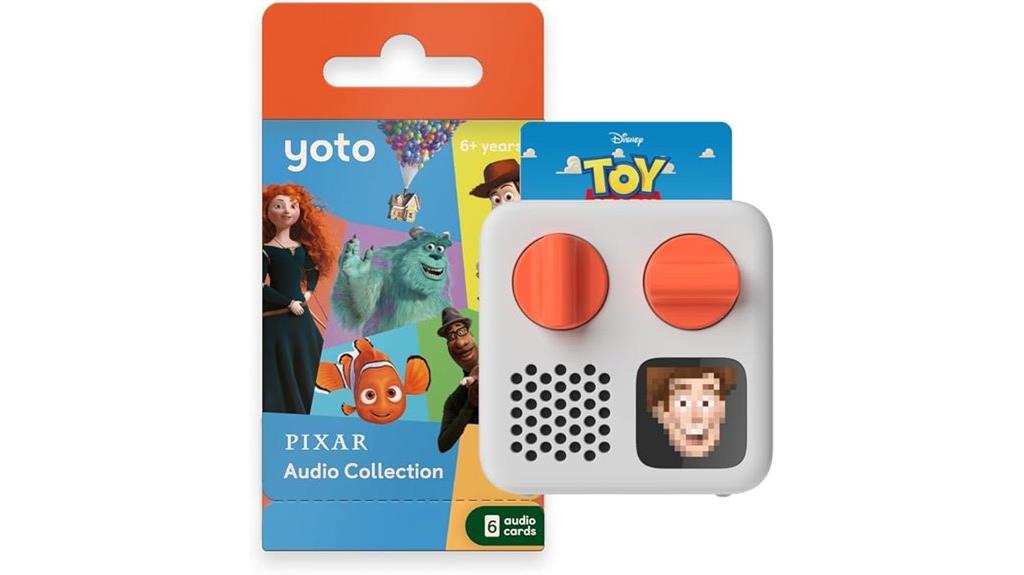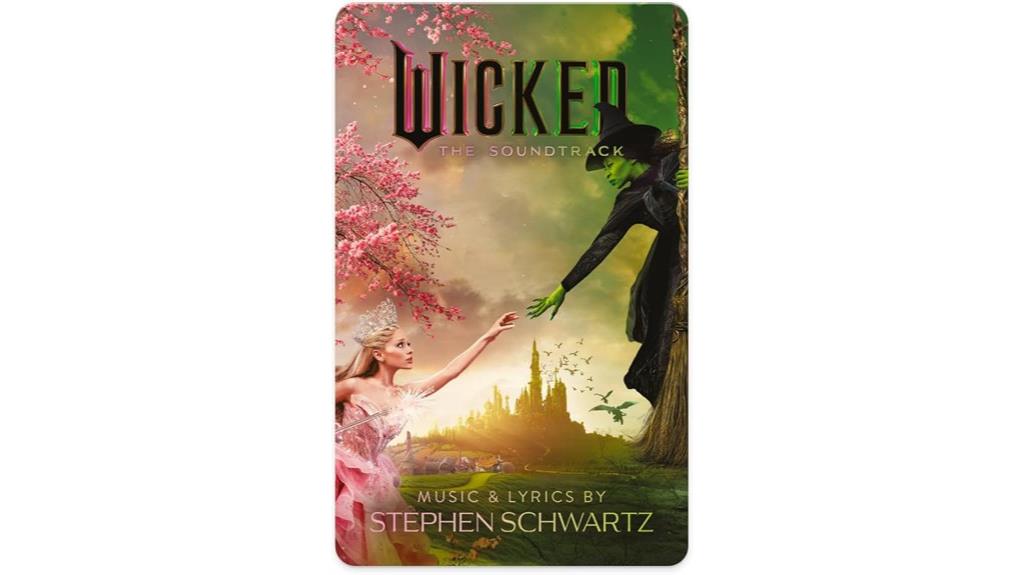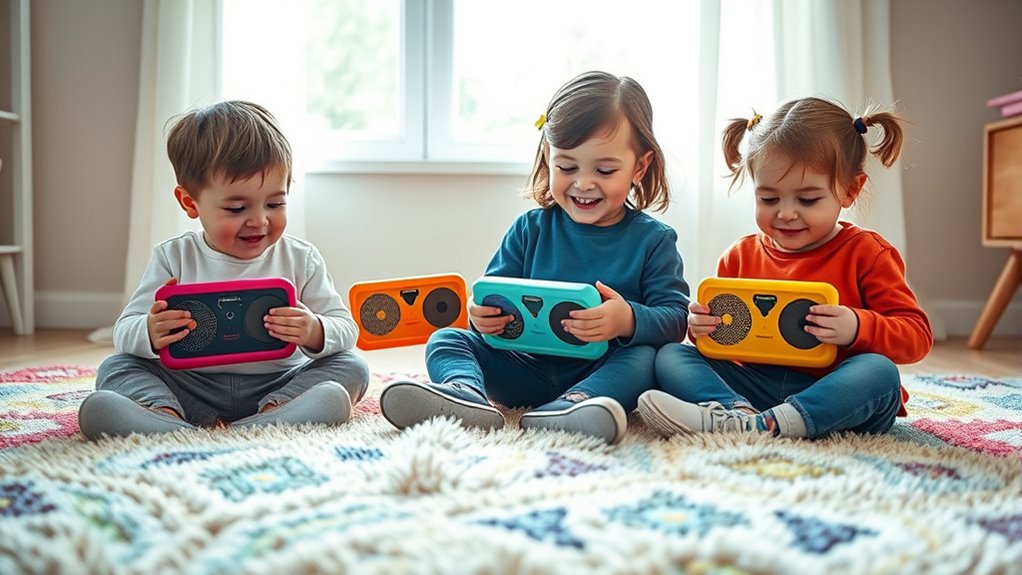When comparing the Yoto Player and Toniebox, I see each has strengths: Yoto offers a vast, easily expandable digital library, while Toniebox provides a simple, tactile experience with physical figures. Yoto’s touchscreen and customizable controls make it feel more flexible, but Toniebox’s durability and straightforward use appeal to little users. To find out which fits your needs best, keep going—you’ll discover clearer insights to help you choose.
Key Takeaways
- Yoto offers a vast, expandable digital library with over 1,000 audio cards, while Toniebox relies on physical figurines with preloaded content.
- Yoto’s touchscreen interface provides intuitive navigation and easy content management via app; Toniebox uses simple physical controls for story selection.
- Toniebox generally has a higher upfront cost with immediate content access, whereas Yoto offers ongoing library expansion at lower incremental costs.
- Both devices are durable and portable, with battery life up to 14 hours, but Yoto’s digital updates ensure continuous content variety.
- Parental controls and customization are more advanced on Yoto through its app, while Toniebox offers tactile, child-friendly interaction with physical figurines.
Yoto Mini (2024 Edition) Bluetooth Audio Player with Disney Pixar Bundle

If you’re looking for a screen-free, versatile audio device for your child, the Yoto Mini (2024 Edition) with the Disney Pixar Bundle is an excellent choice. It’s a compact, easy-to-use Bluetooth player that plays stories, music, podcasts, and more. Just insert an audio card to start listening, or remove it to stop. The free app makes controls simple, and it can be used as a speaker or with headphones. With parental controls, no ads, and up to 14 hours of battery life, it’s safe and reliable. The bundle includes six Disney Pixar story cards, making it perfect for travel, bedtime, or everyday entertainment.
Best For: parents seeking a safe, screen-free, versatile audio device for children that supports storytelling, music, and learning activities on the go.
Pros:
- Easy to operate with simple card insertion and app control
- Safe for children with no cameras, mics, or ads, and parental controls included
- Versatile features including bedtime stories, sleep sounds, alarm clock, and headphone compatibility
Cons:
- Limited to audio content, no visual or interactive features beyond a pixel display
- Requires physical cards for content, which may be lost or damaged over time
- Battery life of up to 14 hours may be insufficient for extended outings without recharging
Yoto Mini (2024 Edition) + Starter Pack for Little Kids Bundle

The Yoto Mini (2024 Edition) + Starter Pack for Little Kids Bundle stands out as an excellent choice for parents seeking a safe, screen-free entertainment option for preschoolers. It includes a compact device with a pixel display, making storytelling and listening interactive and engaging. The bundle features a variety of audio cards, such as preschool songs, sleepy stories, dance activities, and calming music, all designed to support early development. With easy controls, parental monitoring, and up to 14 hours of playback, it’s perfect for on-the-go use. This versatile device promotes imagination, learning, and safe entertainment, making it a valuable addition to any young child’s routine.
Best For: parents and caregivers of preschool-aged children seeking a safe, screen-free way to entertain and educate young kids through interactive stories, music, and activities.
Pros:
- Provides a large library of over 1,000 curated audio cards for diverse entertainment and educational content
- Easy to use with simple tap controls and parental monitoring features
- Portable and versatile, suitable for travel, bedtime, or quiet time with up to 14 hours of playback
Cons:
- Limited to audio content, which may not appeal to children seeking visual entertainment
- Requires purchasing additional cards for expanded content beyond the included starter pack
- The pixel display, while interactive, may be less engaging than a touchscreen or tablet for some children
Yoto Wicked Kids Audio Card for Player & Mini All-in-1 Audio Player

For parents seeking a safe, screen-free entertainment option for their children, the Yoto Wicked Kids Audio Card offers an excellent solution. Compatible with Yoto Player and Mini, it features a fun Wicked soundtrack, stories, and activities with a 56-minute runtime suitable for all ages. Just insert the card into the device to play, and remove it to stop—it’s that simple. The curated content library exceeds 1,000 cards, including books, music, soundscapes, and podcasts. Controls are easy to use via the device or free app, making it perfect for playtime, travel, or holiday parties. It’s a safe, versatile way to keep kids entertained without screens.
Best For: parents and caregivers seeking a safe, screen-free entertainment option for children of all ages that combines storytelling, music, and activities.
Pros:
- Easy to use with simple insert-and-play functionality compatible with Yoto Player & Mini.
- Curated library of over 1,000 cards including books, music, soundscapes, and podcasts.
- Safe, screen-free, ad-free content designed specifically for children, offering versatile entertainment for various settings.
Cons:
- Limited to Yoto devices; requires purchase of the Player or Mini to use.
- Content selection depends on the available card library, which may require additional purchases for variety.
- As a physical card, it may be lost or damaged if not handled carefully.
Factors to Consider When Choosing Yoto Player Vs Toniebox Review

When choosing between a Yoto Player and Toniebox, I consider factors like the variety of content available, how durable and appealing the device is, and how easy it is for my child to use. Parental controls, portability, and battery life also play a big role in making the right choice. Let’s explore these points to find the best fit for your needs.
Content Library Variety
Have you ever wondered which device offers a more varied content selection for kids? I found that Yoto players provide access to over 1,000 audio cards, including stories, music, podcasts, and activities, giving a broad and diverse library. This digital setup makes it easy to update and expand content through card purchases or downloads, so the library can grow over time. In contrast, Toniebox relies on physical Tonies figures, each preloaded with specific stories or songs. While charming, this limits immediate variety, as new content requires buying additional figures. Both platforms curate content well, but Yoto’s digital approach generally offers more flexibility, variety, and ease of expanding the library, making it a strong choice for families seeking extensive options.
Device Durability and Design
Choosing a durable and well-designed device is essential since kids can be rough with their toys. I look for models with strong build quality, often featuring reinforced materials that withstand drops and rough handling. The design should be child-friendly, with ergonomic shapes that are easy for little hands to hold and operate comfortably. Waterproof or splash-resistant features are a bonus, especially for outdoor use or travel. I also check that buttons and controls are sturdy and responsive, so they don’t break or become loose over time. A good device balances aesthetic appeal with durability, ensuring it can stand up to active, energetic environments. Overall, a well-made, thoughtfully designed device lasts longer and offers a better experience for kids and parents alike.
Parental Control Features
Parental control features are essential for ensuring kids access appropriate content and use their devices safely. Yoto players offer content moderation, device locking, and app-based management, allowing me to curate and approve my child’s library, preventing access to unsuitable material. These controls give me peace of mind knowing I can customize what my child listens to and when they can use the device. Toniebox, on the other hand, provides physical volume limiters and app settings to restrict content and manage playback, making it simple to control listening levels and restrict features. Both platforms have remote management tools, but Yoto’s app-based controls tend to be more detailed and customizable, giving me better oversight of my child’s device usage.
Ease of Use
When evaluating ease of use, both Yoto Player and Toniebox stand out for their simple, child-friendly designs that make operation straightforward. The Yoto Player uses physical cards that children insert to select content, eliminating complex menus and making it easy for kids to operate independently. Meanwhile, the Toniebox operates with figurines called Tonies, which are simply placed on top of the device to start stories or music. Both devices avoid screens during playback, reducing visual clutter and confusion. Additionally, the Yoto app allows parents to control and customize content easily, adding a layer of convenience for guardians. Overall, their intuitive designs ensure children can navigate and enjoy their media without frustration, making them accessible options for young users.
Portability and Battery Life
Portability and battery life are essential factors to contemplate if your child enjoys entertainment on the go. A lightweight design makes it easy for kids to carry devices during travel or outings, enhancing their independence. Devices with quick-charging features help minimize downtime, so children can stay engaged with minimal interruption. The compact size of many models allows them to fit comfortably into small hands or backpacks, ensuring portability isn’t compromised. Battery life varies across models, with some lasting up to 14 hours on a single charge, supporting all-day use without needing frequent recharges. These factors are crucial for maintaining continuous entertainment during trips, errands, or outdoor adventures, making them indispensable considerations when choosing between a Yoto Player and a Toniebox.
Price and Value
Choosing between a Yoto Player and a Toniebox often comes down to how much value you’ll get for the price. Yoto offers over 1,000 cards, providing a wide variety of content that can make it more affordable long-term, especially if you enjoy customizing with downloadable or subscription content. In contrast, Tonieboxes tend to have a higher upfront cost but often come with preloaded stories and bundled content, which can be a better deal if you prefer ready-to-use options. Keep in mind, individual Yoto cards can add up over time, whereas Tonie figures usually include multiple stories from the start. Additional features like durability, parental controls, and sleep sounds also influence the overall value relative to what you pay.
Compatibility Options
Compatibility options play a crucial role in selecting between a Yoto Player and a Toniebox, as they determine how easily you can access and customize content. I consider whether the device supports Bluetooth, Wi-Fi, or physical card insertion, which affects how flexible the content options are. Some devices can handle audiobooks, music, podcasts, and personalized stories, making them versatile for different interests. I also look at compatibility with third-party apps or content libraries, as this can expand what’s available and simplify updates. Connecting to headphones or external speakers is another factor, especially for private listening. Lastly, I check if the device suits various age groups, ensuring the content delivered is appropriate and engaging for your child’s developmental stage.
Frequently Asked Questions
Which Device Offers Better Sound Quality for Young Children?
I believe the Yoto Player offers better sound quality for young children. Its clear, crisp audio enhances storytelling and music, making it more engaging. The volume control and audio customization also give me confidence that my child can enjoy high-quality sound without distortion or sudden loud noises. Overall, I find the Yoto Player’s sound quality superior, which keeps my child entertained and immersed in their favorite stories and songs.
Are There More Content Options Available for Yoto Player or Toniebox?
Imagine a treasure chest of stories—now, which device offers more of it? The Yoto Player has a vast library, including music, stories, and educational content, constantly expanding. The Toniebox also offers a rich selection but tends to be more curated. If variety is your goal, I’d say Yoto provides more content options, making it a versatile choice for curious young minds enthusiastic to explore endless adventures.
How Do Battery Life and Portability Compare Between the Two Devices?
I find that the Yoto Player generally has a longer battery life than the Toniebox, making it more suitable for extended outings. The Yoto is also more portable, thanks to its slim design and lightweight build, so I can easily carry it around without hassle. In contrast, the Toniebox is bulkier, which might be less convenient for travel. Overall, if portability and battery life are priorities, the Yoto wins out.
Can Parents Easily Manage Content and Volume Controls on Both Devices?
Imagine holding the remote control of a ship’s wheel — that’s what managing these devices feels like. I find both Yoto and Toniebox straightforward to operate, with intuitive controls for volume and content. Yoto’s app gives me a digital dashboard, while Toniebox’s simple buttons are like friendly nubs. Managing content and volume is easy, giving me peace of mind knowing I can steer my child’s listening experience effortlessly.
Which Device Has a More Durable and Child-Friendly Design?
I find the Toniebox more durable and child-friendly because it’s built with soft, rubbery edges that can handle drops and rough handling. Its sturdy design and rounded corners make it safe for little hands, unlike the Yoto Player, which is more plastic and sleek but less resilient. For active kids, the Toniebox’s rugged construction gives me peace of mind knowing it can withstand their adventures.
Conclusion
Choosing between the Yoto Player and Toniebox feels like selecting a trusted compass for your child’s adventure. Each has its unique spark, guiding little explorers through worlds of sound and stories. While the Yoto offers versatility and tech-savvy features, the Toniebox brings simplicity and charm. Ultimately, it’s about which beacon lights up your child’s curiosity. Whichever you choose, you’re gifting them a journey—and that’s the true treasure.









